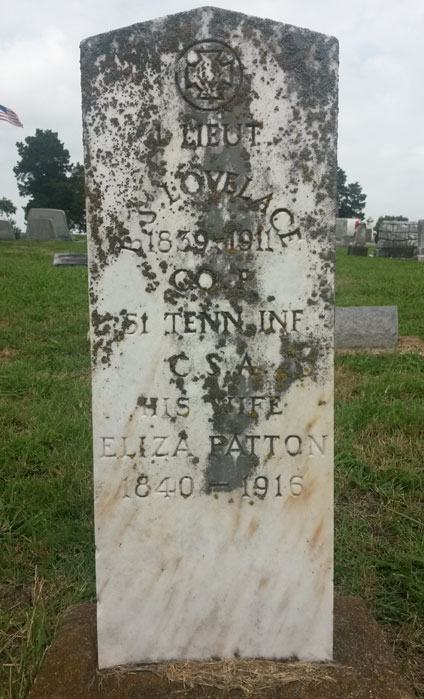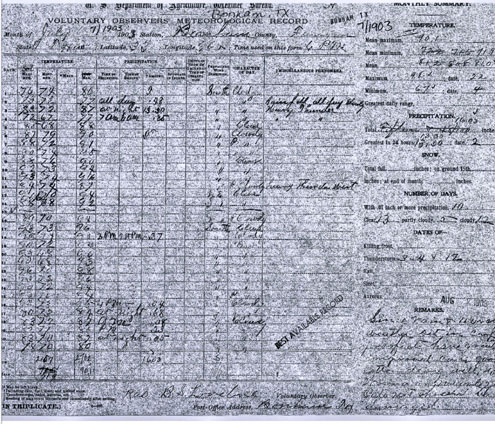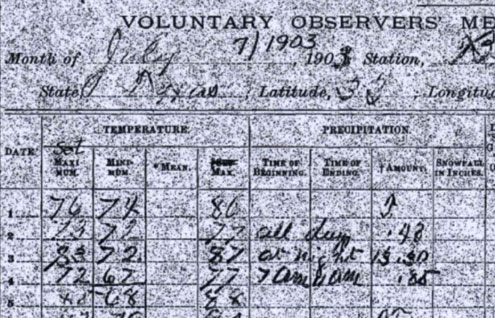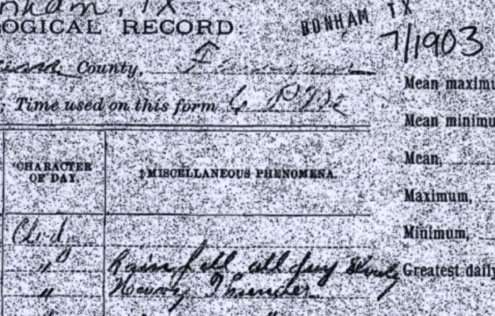The recent rains and flooding have been impressive. Water has gone over the spillway at Texoma twice; local cities have seen serious damage to roads and bridges; and to top it all, the only bridge connecting Fannin County to Oklahoma has again washed out on the Oklahoma side, just as it did in 1941. But all of this record rainfall has come over a span of weeks. Therefore, perhaps it still pales in comparison to the massive storm system that slammed North Texas one night in the early summer of 1903.

Census records show that in 1870 Lovelace was the owner of a general merchant store in Henderson, Tennessee; by 1880 he was the town's postmaster. Sometime between then and 1900 he and his family left Tennessee for North Texas. The 1900 census shows Lovelace as a grocer in Bonham.
In addition to selling groceries, Lovelace stayed busy keeping local records for the U. S. Department of Agriculture Weather Bureau. On most days the numbers he recorded were largely mundane and unimpressive. That changed on July 3, 1903.

Then, as now, heavy rains tended to be over by early July, most folks going about their daily routines not having to worry about or plan around heavy rains. At that time in 1903 everyone was probably planning for a big July 4th celebration. Mother Nature threw everyone a changeup.
Sometime around 11 p.m. on July 2nd a light rain started falling in Bonham. By midnight it turned into an ugly storm. The July 4th Dallas News described it this way:
Between 11 and 12 o'clock last night began the fiercest rainstorm in the history of Bonham or of (Fannin) county, and from that hour until 6 o'clock this morning rain fell in solid sheets, and with the deep thunder and continuous flash of lightning caused consternation everywhere throughout the city. Streets were converted into rivers, water being from three to six feet deep all over town, a correct gauge showing the fall to have been 13 1/2 inches.
(Historical photos of Bonham in 1911, taken by Erwin Smith and found on the Amon Carter website, clearly show that city streets were not paved even by that year. So it's safe to assume that the flooded streets of 1903 were indeed a huge muddy mess. Travel even by horse and buggy had to be difficult for quite some time.)

The July 5th Fort Worth Telegram gave a similar description of the Bonham storm:
The heaviest rain this country has ever had fell yesterday (referring to the 3rd) morning. It began raining about 12 o'clock and continued with a downpour until 6 o'clock without the least intermission. At times the wind blew at a fearful rate and the lightning and thunder were terrific.
It went on to say that the "government rain gauge showed a fall of 13.31 inches, and the streets were like rivers. Powder Creek was several feet above the high water mark."
The rain gauge both papers referred to was the one kept by B. S. Lovelace. A photocopy of his entry is part of this article.

Key businesses that suffered due to flooding were the railroads and the cotton mill, located next to the railroad tracks.
The Fort Worth Telegram reported that three bridges were washed out between Bonham and Denison shutting down the Missouri, Kansas & Texas Railroad (aka, the Denison, Bonham & New Orleans Railroad). Moreover, it stated that the "Texas and Pacific railroad suffered great loss near the roundhouse, where the water was up in the cars. The turntable was washed completely out, leaving the roundhouse full of engines. Only one engine was on the outside." Moreover, it noted that the T&P bridge west of the roundhouse was washed out, thus stopping traffic for a while. The Dallas News reported that T&P crews were busy working to repair the bridge of the roundhouse turntable.
Damage and flooding at the Bonham Cotton Mill was best detailed in the July 4 Dallas News:
The lower floor and basement of the mills were flooded for several hours. T. L. Clark, superintendent of the cotton mills, stated to The News reporter tonight that their losses would be fully $3,000 and the mills would be suspended for two three weeks for repairs. As this enterprise runs night and day and is already behind with it's orders, the storm was a serious blow to it. The mills were forced to close at 4 o'clock this morning, and several of the employees narrowly escaped being drowned. A cable was stretched from the top of a string of boxcars (sitting on the tracks just to the north) to the mills, and all the women and children piloted safely across, while the men swam to safety.
The Fort Worth Telegram told a story of near tragedy among those swimming for safety from the cotton mills:
One man undertook to swim out with his children on his back, and his boy, 9 years old, lost his hold and drifted away into the darkness. The father was frantic and made a great effort to save his child, without success. The little fellow was carried down stream a piece, where he was fortunate in catching a limb and climbed into a tree, where he was rescued later.
The reason for even more serious flooding in the cotton mill/roundhouse area is twofold: First, Powder Creek has always been notorious for flooding during heavy rains. Secondly, in 1903 the T&P lake, created by damming up the creek, and located just west of the cotton mills and just south of the roundhouse/turntable area, was still in use to provide water for steam locomotives. It obviously flooded like crazy as well. Neither the creek nor the lake stood a chance against more than thirteen inches of rain in roughly six hours.
The July 19 Dallas News reported that the Bonham Cotton Mill was back in operation by Monday, July 22. (It should be noted that the rains no doubt stalled progress on a highly-anticipated new building in town, the Allen Memorial Hospital.)
In an effort to understand the scope and size of the storm, clippings from various North Texas newspapers reported heavy rain, flooding and damage to businesses from Gainesville to Paris and from the Red River to Mckinney and Frisco.
Thanks to serious flooding along Bois d' Arc Creek and Bois d' Arc bottom, tons of animals, large and small, wild and domestic, were killed. The July 10 Dallas News described the ugly aftermath:
The problem confronting the farmers living in the bottom lands of Fannin County at the present time is the disposal of the large amount of dead stock that has accumulated since the recent heavy rain and flood. All along Bois d' Arc Creek are dead horses and cattle in the drifts and along the banks, and with the hot weather that is coming, in a short while the sanitary conditions there would be anything but inviting.
Farmers were in town from Danner today to buy 100 gallons of oil, intending to gather and burn the carcasses. Several farmers lost all of their stock.
Rotting livestock along Bois d' Arc Creek also posed a large public health threat because in 1903 the City of Bonham was supplementing its water supply, from the city lake east of town, by pumping water out of the creek.
Denison's Sunday Gazetteer of July 19 reported a similar problem there:
The Munson pasture north of Denison only two miles, is the dumping place for dead animals. Under the existing circumstances it is a wonder that Denison is healthy. Dead animals should be cremated instead of being dumped to rot and fester in the hot sun to pollute the atmosphere.
The situation was no doubt the same in Bonham. Most people still traveled by horse and buggy in 1903; an automobile was still just a rare novelty. As a result, there was quite a few large animals within the city limits, and many of them no doubt drowned in the flood waters. Proper disposal of the dead carcasses was undoubtedly a huge headache.
As the month of July passed, citizens of Fannin County began recovering, as noted in various Bonham News clippings from surrounding communities. The July 24 edition carried a dispatch from Monkstown noting that the people there were "very busy working their crops as the flood of July 3rd and 4th did a great deal of damage to their cops." It further noted that "Sam Goss was building a new bridge across Bois d' Arc Creek on the road leading to Honey Grove from this place." The old bridge no doubt fell victim to the flood.
The same issue had a report from Danner as well stating that it was their "first attempt to write since the flood. We have been busy trying to get ourselves straightened out again." It further noted that the potato and corn crops had been drowned.
And the July 31 issue carried the following from Ivanhoe: "A light shower fell here on the 26th which was the first we have had since the flood."
As the newspaper clippings indicate, the legendary storm of July 3,1903, which dumped well over thirteen inches of rain in roughly six hours, became known as, and no doubt was long remembered as..............the flood.
Big thanks to Michael Bennett with the Collin County Courthouse for sharing information about B. S. Lovelace and sharing the photo image of his weather log entries as well.
Tim Davis teaches at Bonham High School.